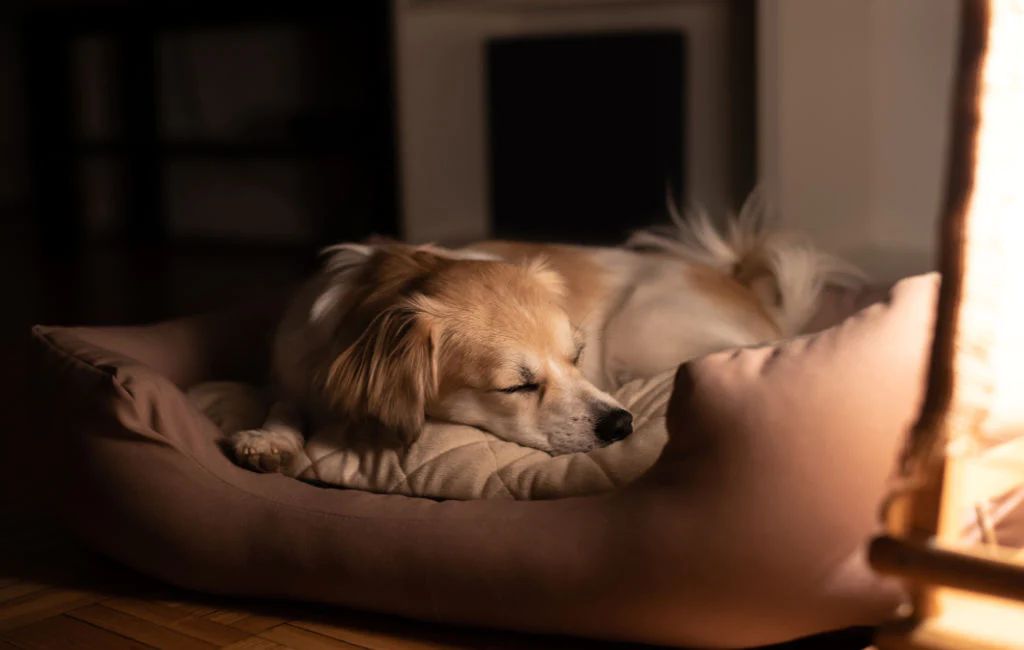Introduction
https://buddyrest.com/blogs/buddyblog/phases-of-dog-sleep-cycles – Dogs go through multiple sleep cycles each day, alternating between REM and non-REM sleep. Like humans, dogs cycle through stages of sleep that include light sleep, deep sleep, and REM sleep where dreaming occurs. The amount of time spent in each stage and the number of sleep cycles varies by dog based on breed, age, and other factors.
https://www.ncbi.nlm.nih.gov/pmc/articles/PMC7401528/ – Most dogs sleep 10-14 hours per day on average. Puppies and older dogs tend to sleep more. Sleep patterns change as dogs mature. Understanding dog sleep cycles, the stages they go through, and factors that affect their sleep can help owners support their dog’s health and well-being.
REM vs non-REM sleep
Dogs experience two main types of sleep: REM (rapid eye movement) and non-REM sleep. REM sleep is when dogs are dreaming, while non-REM sleep is restful sleep without dreaming.
During REM sleep, a dog’s brain is very active, their eyes move rapidly behind closed eyelids, and their muscles become temporarily paralyzed. This is when vivid dreaming occurs. REM sleep is critical for dogs as it’s involved in memory consolidation and learning. Dogs typically spend about 10-30% of their sleep time in the REM stage. Puppies and younger dogs tend to have more REM sleep.
Non-REM sleep accounts for around 70-90% of a dog’s overall sleep. There are three phases of non-REM sleep, ranging from light to deep sleep. In the lighter stages, dogs can be easily woken, while in deep non-REM sleep, it’s difficult to rouse them. Non-REM sleep allows dogs’ bodies to restore and recharge.
The alternation between REM and non-REM sleep is part of a normal sleep cycle in dogs. Dogs cycle through these stages multiple times during their overall sleep period. Understanding the differences between REM and non-REM sleep sheds light on the complex sleep patterns of our canine companions.
Sources:
https://buddyrest.com/blogs/buddyblog/phases-of-dog-sleep-cycles
https://www.nature.com/articles/s41598-020-67092-5
Dog Sleep Stages

Like humans, dogs experience different stages of sleep. However, dogs’ sleep cycles tend to be much shorter compared to humans. The average dog will experience about 20 or more sleep cycles throughout the night, whereas humans only experience 4 or 5 sleep cycles on average (https://buddyrest.com/blogs/buddyblog/phases-of-dog-sleep-cycles).
There are two main sleep phases in dogs:
REM sleep: This stage is characterized by rapid eye movement and brain activity. During REM sleep, dogs are lightly sleeping and it’s easy to wake them up. Dogs spend about 10% of their sleep time in the REM stage, which is when dreaming occurs.
Non-REM sleep: This is a deeper stage of sleep where brain and muscle activity slows down. Non-REM sleep is divided into light sleep, moderate sleep, and deep sleep stages. Dogs spend most of their sleeping time in non-REM sleep.
Initially when a dog falls asleep, they experience light non-REM sleep. As they continue sleeping, they progress into deeper non-REM sleep stages. After some time, they then enter REM sleep before cycling back to lighter non-REM sleep. This full sleep cycle lasts around 10 minutes in dogs (https://www.hundeo.com/en/magazine/how-long-sleep-dogs/).
Do dogs dream?
Yes, dogs do dream just like humans do. During sleep, dogs go through different sleep cycles including REM (rapid eye movement) sleep where dreaming occurs. According to the American Kennel Club, when dogs are in REM sleep you can notice their eyes moving beneath their eyelids and their legs twitching as they experience dreams.
Researchers have found that dogs and other animals have complex dreams and can remember and replay sequences of events that happened while they were awake. The parts of a dog’s brain that handle emotions are active during REM sleep suggesting dogs are experiencing emotions in their dreams just like humans do. Some common behaviors dogs display during REM sleep that indicate they are dreaming include whimpering, growling, barking, running, chewing motions, and twitching.
While we can’t know for sure what dogs are dreaming about, it’s believed they dream about common experiences from their waking lives. This could involve positive dreams about playing, going for walks, eating treats, being petted, etc. But dogs may also have stressful or frightening dreams about past traumas, loud noises like fireworks, encounters with other animals, going to the vet, or getting in trouble.
Light vs deep sleep in dogs
Dogs, like humans, cycle through different stages of sleep. Light sleep occurs during the initial periods of sleep. During light sleep, dogs are relatively easy to wake up and often twitch. Their eyes move behind closed eyelids as they start dreaming. Light sleep transitions into deep or slow-wave sleep. Deep sleep is characterized by reduced respiration, heart rate, and body temperature. Dogs are difficult to wake up during this stage. They may make leg twitches as their brains fire during dreaming. Deep sleep is important for physical restoration. The deepest stages occur early in the sleep period. As the night goes on, dogs spend more time in lighter stages of sleep (1).
The amount of time spent in light vs deep sleep varies between dogs based on age, breed, and other factors. Puppies and senior dogs tend to have more light sleep. Anxious or stressed dogs are also prone to restless, light sleep. Most adult dogs spend about 50% of the night in deep sleep and 50% in light sleep. Deep sleep is crucial for brain function and maintaining a healthy immune system (2).
Sources:
(1) https://www.masterclass.com/articles/how-dogs-sleep
(2) https://buddyrest.com/blogs/buddyblog/phases-of-dog-sleep-cycles
Sleep disorders in dogs
Just like humans, dogs can suffer from various sleep disorders that disrupt their normal sleep patterns and prevent them from getting the deep, restorative sleep they need. Some of the most common sleep disorders seen in dogs include:

Insomnia – Inability to fall asleep or stay asleep through the night. This can be caused by anxiety, stress, pain, itching, dementia, or other medical issues.
Sleep apnea – Pauses in breathing during sleep caused by airway obstruction. Dogs with shortened snouts like bulldogs are prone to this.
Narcolepsy – Characterized by sudden, uncontrollable bouts of sleep. Narcoleptic dogs may collapse or fall asleep suddenly.
REM sleep behavior disorder – Acting out vivid dreams by vocalizing, running, and other movements during REM sleep.
If a dog is displaying signs of a sleep disorder, a vet should be consulted to rule out any underlying illness and provide appropriate treatment to help the dog sleep better.
How much sleep do dogs need?
Experts recommend that puppies sleep about 18 to 20 hours per day in order to support their rapid growth and development. Adult dogs generally need less sleep, though recommendations vary by age and breed.

According to the Sleep Foundation, most adult dogs require 8 to 13.5 hours of sleep per day, with an average of just under 11 hours [1]. PetMD states that on average, adult dogs sleep around 12 hours in a 24-hour period. However, larger breeds and senior dogs may need closer to 14-15 hours of sleep in a day [2].
In general, puppies and younger dogs need more sleep to support growth, while older dogs need extra sleep to recover from age-related issues. Knowing the recommended hours for your dog’s age and size is helpful for ensuring they get adequate rest.
Tips for better sleep
Creating a sleep-friendly environment is crucial for helping dogs get the rest they need. Here are some tips:
Establish a relaxing pre-bedtime routine, like taking a short walk followed by quiet time at home. This signals to your dog that it’s time to wind down (Chewy).
Keep your dog’s sleep area clean, comfortable, and free of loud noises or other disturbances. Place their bed in a low-traffic area of your home (Chewy).
Make sure your dog has a cozy, dedicated sleeping space, like a crate or dog bed. Outfit it with familiar blankets or toys (Chewy).
Consider using calming supplements or essential oil sprays designed to relax dogs before bedtime (Soopapets).
Stick to a regular sleep schedule as much as possible, just like you would for a human family member (Chewy).
If your dog struggles with anxiety at night, speak to your vet about anti-anxiety medication or natural calming aids that may help (Soopapets).
Signs of sleep deprivation
Not getting enough sleep can greatly impact a dog’s health and behavior. Dogs that are sleep deprived may exhibit symptoms like hyperactivity, lethargy, irritability, lack of focus, anxiety, excessive barking or whining, aggression, destructive behaviors, pacing or restlessness, and reduced interest in play or training. Prolonged sleep deprivation in dogs can also lead to more serious health issues like obesity, cognitive dysfunction, and immune system problems.
According to https://myslumberyard.com/sleep/is-my-dog-getting-enough-sleep/, some signs that a dog isn’t getting enough sleep include staring into space, confusion, and incessant barking. Dogs experiencing sleep deprivation may seem overtired yet unable to settle down and sleep. They may pace, seem restless, and have difficulty focusing or following commands.

If a dog goes 24 hours or more without sleep, they can experience more severe symptoms like tremors, vomiting, diarrhea, and collapsing. Prolonged lack of sleep is very dangerous for a dog’s health. If a dog is showing signs of extreme sleep deprivation, a vet should be consulted right away.
Conclusion
So in summary, yes dogs do fully fall asleep during the deep sleep REM stage just like humans. During deep REM sleep, a dog’s brainwaves show the same activity as if they were awake, indicating dreams and full unconsciousness. Non-REM sleep, while not as deep, is also characterized by muscle relaxation and reduced consciousness. Good quality sleep, with adequate time spent in both REM and non-REM stages, is vital for a dog’s growth, learning, memory, and health. Lack of sleep can lead to behavioral issues and health problems. Ensuring your dog gets enough daily sleep and has a comfortable sleeping environment will support their development and wellbeing.
